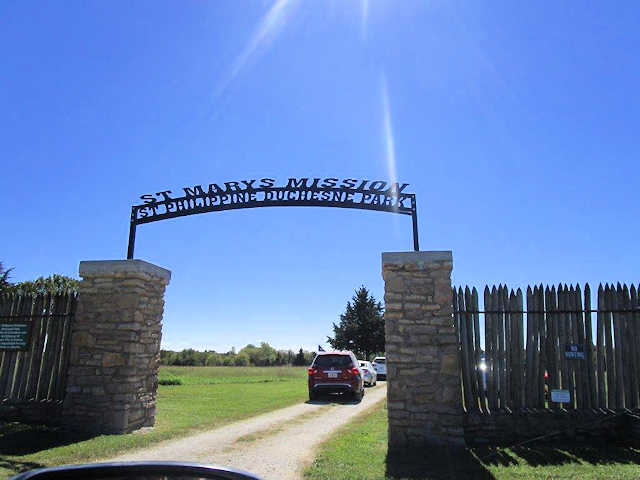| Trail of Death Caravan Across Kansas By Shirley Willard, Fulton County Historian |
|
Sep 22, the last day of our journey, found us in western Missouri. We followed the Trail of Death route through Grandview, south of Kansas City. The Trail of Death marker is on Red Bridge Road but the red bridge is gone. After crossing into Kansas, we drove by the Trail of Death marker at Olathe’s Heritage Park. In Paola we visited the Miami County Swan River Museum. The Trail of Death historical marker is in the town park across the street. Entering Osawatomie, we passed the Old Land Office on North Sixth Street. The office is a tiny building about ten feet square. Rev. John Wastlund and Osawatomie Ministerial Association had prepared lunch for the caravan the Osawatomie City Auditorium. The Band of Oz played old time tunes while we ate. “Alexander’s Rag Time Band” and “Swing Low Sweet Chariot” were a couple of songs I recognized. The Band of Oz took up a collection and presented me with the money. I will use it to write a report about the caravan and mail to all the people on the trip and the places that I can get addresses for. At 12:30 we headed southwest to the old Sugar Creek mission, now named St. Philippine Duchesne Memorial Park. She was an elderly nun who was a missionary to the Potawatomi and became known as She Who Prays Always. She was canonized in 1988, the only female saint west of the Mississippi River. The park is located in rural Linn County about 20 miles south of Osawatomie, Kansas, and consists of about 400 acres purchased by the Diocese in 1988. It has seven crosses with names of the 600+ Potawatomi who died there in the next 10 years. It also has the 14 Stations of the Cross, a replica trading post, and the Indian well down the ravine by Sugar Creek. (Many states have a Sugar Creek which means there are maple trees beside the creek.) Janet Pearl, a Citizen Potawatomi and descendant of the Trail of Death, had arranged for Mass at the end of our journey, Father Barry Clayton, pastor of three local Catholic parishes, offered communion. The ceremony was outdoors at the huge circular St. Philippine Duchesne altar and the 30 foot tall metal cross. The weather was perfect and the tall trees lent shade to the audience seated in folding chairs brought by the local churches. Linn County Historical Society, led by Ola May Earnest, provided a potluck supper in the replica “trading post” at St. Philippine Duchesne park. Ola May’s four teenage granddaughters helped serve the food and make sandwiches, giving us a choice of turkey, ham, beef or pulled pork. What a wonderful ending for our journey. We remember the stories told by the people we met along the way. They gave us bits of oral history, pieces that are missing from our past. The couple who told there were two Indians buried near where their swing set was, Wayne Mountain’s relatives showing us a photo of their great-grandmother in full Potawatomi regalia. These are important pieces of the puzzle we are all trying to fit together. We learned more history every day. Now a note about the future. At age 82, I am not going to organize any more Trail of Death caravans. I am passing the torch to Kim “Spirit Hawk” Oden Setnor, who is good at computer publishing. She will be taking over the newsletters in 2019. I will finish up the year by doing the last Potawatomi Trail of Death Association newsletter and the last Fulton County Folk Finder. Kim will do a newsletter for Fulton County Historical Society that will include the elements of history and genealogy. I will continue to write my weekly column for the Sentinel, some of which Kim will probably put in the newsletter. This newsletter will be Fulton County Historical & Genealogical News.  The end of the Potawatomi Trail of Death is the former St Mary’s Mission, now the St. Philippine Duchesne Memorial Park near Mound City, Kansas, where a Catholic church also has a memorial to St. Philippine.
The end of the Potawatomi Trail of Death is the former St Mary’s Mission, now the St. Philippine Duchesne Memorial Park near Mound City, Kansas, where a Catholic church also has a memorial to St. Philippine.
|
| < Previous | Home | Next > |